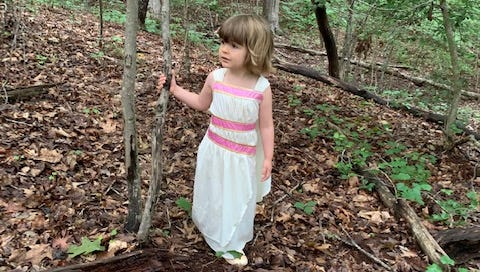A biology teacher I once taught with had a good trick for improving your tree identification skills. She called it, “getting to know your trees” and it involved taking walks in the woods or in a neighborhood, picking up or plucking leaves, comparing them to a pocket guide, and carrying them around. It worked better than studying the pocket guide in the classroom because it was tactile.
I thought this was great advice, and is probably a good way to learn most things in nature. You can’t do this with snakes, though—for all kinds of reasons—and when I try to remember mnemonics like “red touches yellow, kill a fellow” it also becomes “yellow touches red, safe for Fred” in my mind. The actual saying for telling the highly venomous coral snake apart from the harmless scarlet king snake is:
Red Touch Yellow - Kills a Fellow
Red Touches Black - Friend of Jack
Or:
Red Touch Black - Venom Lack
Yellow Touches Red - Soon You'll Be Dead
Lucky for us, coral snakes are seldom seen in North Carolina, and not in our part of the state (also, in tropical places, there are many kinds of venomous triple-banded snakes, so it might not be a great saying to go by). A coral snake bite has actually never been recorded in North Carolina. Phew.
Most of North Carolina’s commonly seen snakes are nonvenomous, and all of them want little to do with us. The ones that crawl into our attics and up in our porch rafters, dropping down onto our shoulders (this happened to me once) or up the wall next to our bathtubs (happened to Mamie) are most likely rat snakes. They’re great climbers, and nonvenomous.
The venomous snake you are most likely to see near your house is probably a copperhead. These snakes are dangerous, but according to the North Carolina Museum of Science their bite is “relatively mild,” though very painful. Deaths from copperhead bites are rare. Still, any snake bite should get medical attention!
Here’s what the NC Museum of Science advises if you’re bitten by a snake:
Stay calm. Call 911 or Carolina’s Poison Center at 1-800-848-6946.
Try to identify the snake by sight only. Look for color, markings and head shape.
Do not try to kill the snake; it could bite again.
Keep the patient calm and immobile (preferably lying down).
Keep the affected limb at an even level with the rest of the body.
Do not use a tourniquet.
Do not cut the wound.
Do not try to suck out the venom.
Do not pack the wound in ice.
Unfortunately, a lot of snakes look like copperheads. The best thing you can do when you see a snake is give it distance, but of course it’s helpful to be able to identify them.
Here is a useful list of eight copperhead lookalikes. The common water snake is the closest lookalike around here, and we see it often in the Haw.
The best way I know of spotting a copperhead is not by looking at its head shape, but noting the bands that run across its body. They look like hourglasses, or even more strikingly, like two Hershey’s Kisses, touching.
Even though copperheads are dangerous, experts say you shouldn’t kill them. This can lead to a bite, for one thing, and for another, they are important parts of the ecosystem, keeping down the rodent population. As reptile specialist J.D. Kleopfer told the Richmond Times-Dispatch, “More people are killed by dogs, but if you see a stray dog walking down the road, you are not going to” kill it. Makes sense to me.
Finally, the biggest danger for snakes? You guessed it, habitat destruction caused by human construction of houses, roads, shopping malls and more. In North Carolina, eight of our 37 native snake species are endangered or threatened. As with most animals, we are a bigger threat to them than they are to us.
Maybe the best thing we can do for snakes is learn more about them, so we can be inspired to help protect them. Bea told me yesterday that she wants to be a biologist when she grows up, and I think that’s pretty cool. She doesn’t want specialize but wants to study “all animals,” she says. What about you? Any biologists-to-be? If you had to specialize, what group or species would you choose?
We’ll be back on Sunday with a little more on snakes. In the meantime, here are some links we think you might like:
Snake Facts from National Geographic
And more snake facts from Let’s Get Sciencey
“Swamp Things,” a contemporary classic about invasive species in Florida by Burkhard Bilger
A beautiful, eerie slideshow of Everglades photos by Balarama Heller in the New Yorker
What 26,000 Snakes can Teach Us about Climate Change, a recent article from Mother Jones
Here is my favorite tweet about snakes:

Also funny:

Happy Friday!




